Tumblr Funny Snapchat Tumblr Funny Snapchat Drawings
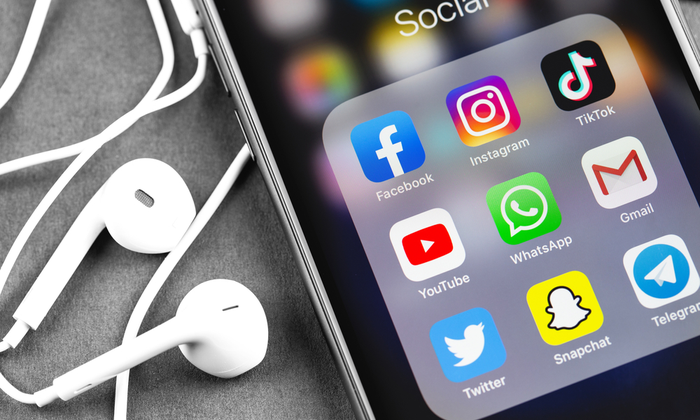
Times are changing. There's more to social media marketing than posting on Facebook and Twitter a few times a day. If you want to build your brand, engage your prospects, and increase sales, it takes time and work.
You need to stand out from a plethora of competitors, social media noise, and even compete with influencers, celebrities, and other big names.
You need a brilliant social media strategy.
Often, like with any innovative marketing, you'll find that you have to step away from traditional social media platforms—and continuously find new ways of reaching your target customers.
The popularity of TikTok highlights the importance of keeping up-to-date with the ever-changing digital world, as to not miss out on key opportunities.
Social Media Marketing Guide Definitions
Here are some common terms you need to know when developing your social media marketing strategy.
Content
Content is whatever you post on social media. It can be a Facebook status update, a video on Instagram, a Tweet, and so on.
Content comes in many different forms, and you need to tailor it to each platform. What's even more important than content, though, is context.
Context
Gary Vaynerchuk said, "Content is king, but context is God."
For instance, you might have a great joke, but if you place it somewhere inside a 3,000-word blog post, very few people are likely to see it. On Twitter, however, that same joke as a tweet might crush it.
Plus, anyone can get in on the fun. When looking at the most retweeted, funniest Tweets ever, we can see even the CIA sees the value in using social media to create some positive buzz.
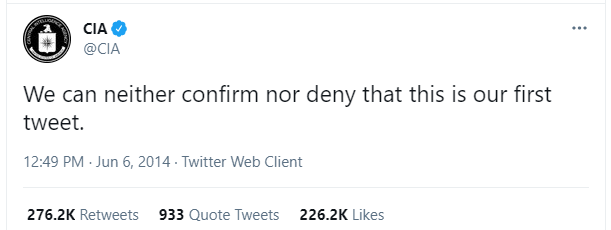
The opposite is also true. Packaging your entire blog post into one tweet is hardly possible, so try a good call to action with some relevant hashtags instead. And that brings us to hashtags.
Hashtags
By now, you probably know that hashtags are a very common tool that people use to add meta information on almost all social media channels. Twitter, Facebook, Instagram, and Pinterest all use hashtags to let you describe the topic of your content or mark it as part of current trends.
They make your content easy for users to discover and therefore more likely that they'll share it.
Shares
Shares are the currency of the social media world.
When people engage and interact with your content, that's good. But when they share it, that is the time to celebrate.
A great social media tool to measure shares and the overall impact of content is BuzzSumo.
The more shares, the more people love your content. Shares are the best form of engagement that people can have.
Engagement
This is a general term referring to how people interact with the content that you produce. It can be a like, a reaction, a comment, or a share. All of these are good, but the shares are where it's at.
Now that we've covered some social media definitions, let's take a look at the core pillars of social media.
Core Pillars of Social Media Marketing
There's no doubt about it: these days, your business needs to be on social media, and you should concentrate at least some of your marketing efforts (and budget) on your social media strategy.
With 4.48 billion people owning social media accounts, there's a whole world of potential customers that any business can access, simply by logging in and creating brilliant content.
Brands like BooHoo, Depop, and Chipotle excel at social media, and there's one simple reason: they integrate the core pillars of social media marketing.
There are five main pillars. Let's talk through them one by one.
1. Strategy
A sound social media marketing strategy is the backbone of your social media presence. Without a strategy, you're wasting time, unlikely to achieve your goals, and will most likely struggle to reach your target audience.
In case you're not sure, a content strategy consists of getting the "Right content, to the right people, at the right time."
In its most basic terms, a content strategy helps you achieve your business goals by enabling you to:
- create valuable content
- drive engagement
- increase conversions
A good social media marketing strategy has clear goals, specific plans to reach those goals, and must be measurable.
Finally, you need to set benchmarks to see how things are going and whether you need to change your approach.
2. Planning and Publish
Social media is a powerful tool, but you can't just go out there and start publishing content without a plan behind it.
When you're planning content make sure that you:
- Know your audience: You need to know the demographic of your audience in order to connect with them.
- Focus on quality: The quality of content is just as important as the quantity.
- Consider your brand: Keeping in line with your brand values is crucial.
When it comes to publishing, there is one golden rule: consistency. A regular publishing schedule keeps people coming back for more.
3. Listening and Engagement
Plan your content and above all, actually engage with your audience.
Your feedback might not always be positive; but, if you don't make changes, neither will the tone of your responses.
Listening and engagement are all part of a successful digital transformation, especially if you're going to enhance the overall customer experience.
It's also worth mentioning that social listening isn't just about customer experience. It can allow you to:
- pick up on new trends
- identify new streams of income
- gain industry insights
- find influencers in your niche
Need some assistance to get started with social listening? Hootsuite has a free introductory tool for measuring key terms and hashtags.
4. Analytics
The success of any social media marketing campaign depends on analytics for tracking and collecting data. Without this information, you can't:
- understand user behavior
- refine your strategy
- find which platform works best for your brand
- discover the best times to post
- analyze your competitors
Once you have all this, you'll know with certainty what works and what doesn't. That way you can spend more time on what does, and waste less. In turn, analytics will inform the decisions that you make for future campaigns—and highly influence the success rate.
Similarly, A/B testing is great for determining what content, design, CTA, etc. work best.
If you've been noticing certain types of content receiving double the engagement than other posts, play on that.
For example, if you're a small business, your followers are most likely going to be family and friends who will love the personal insight and celebratory posts because they care about you and your successes.
Producing high-quality content that your audience isn't interested in will mean that engagement levels tank. You need to work on making sure your posts appear in people's feeds before you start feeding through those insightful industry blogs.
5. Advertising
For anyone looking for an audience, social media advertising is worth exploring. With approximately 2.89 billion active monthly users on Facebook alone, that's an incredible amount of prospects.
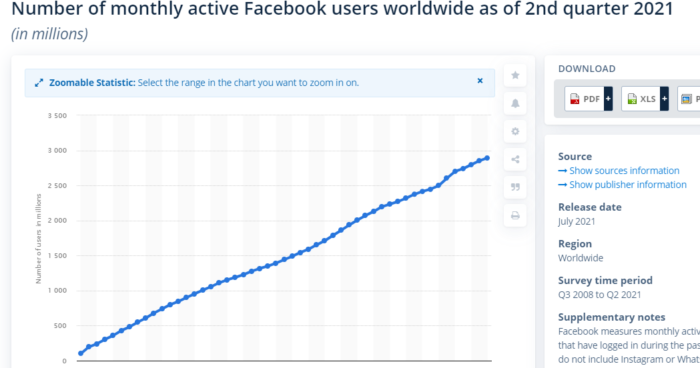
The three main types of social media advertising are:
- Organic: Content that picks up views naturally and you don't pay for.
- Paid: Content that an organization sponsors and therefore costs money to post.
- Earned: Content that has been given freely in the form of shares, likes, and comments.
There are several ways you can advertise on social media. For example, you can:
- Create content: This includes posts and videos.
- Promote content: Create posts that are promoted/sponsored.
- Engage with people: Get active in groups related to your industry, interact with influencers in your industry, etc.
- Grow a following: Get people in your industry to follow your brand by creating and sharing content that appeals to them.
- Get downloads: Offer PDFs, white papers, PowerPoints, videos, podcasts, etc. on your social channels and profiles.
Additionally, if you aim to enhance your brand recognition, build loyalty, and increase conversion rates, advertising could be the way to go.
Aside from these main pillars, you should also:
- ensure you focus your content on a specific niche or demographic
- build quality connections with influencers, brands, and customers you can build relationships with
- add value with your content and comments
Finally, ensure you're accessible on social media so your customers know they can reach out to you. Don't just wait for feedback. Invite it!
Different Types of Social Media Marketing
Aside from the likes of Facebook, Twitter, and Instagram, social media marketing takes many different forms, such as:
- content marketing/content creating
- advertising/sponsorship
- influencer marketing
- social media management/community management
- paid media
- building your following
- contributing to forums
- reviews
If you're serious about growing your brand, don't just focus on the large sites with a vast audience. Although they're an obvious place to start, look for different, more creative ways to engage your prospects and develop leads.
Also, while you're exploring some of these other methods, find which content works best for each channel to optimize your results.
Social Media Marketing Trends to Pay Attention To
The social media world changes faster than any other online space.
Keeping up with it isn't an easy task.
So here are a few trends you'll want to keep in mind. Most likely, these trends will impact not just this year, but also the future.
Here's what they are.
Organic Reach is Down
Once upon a time, a social media user could post compelling content and easily grow their social media following.
After a few months, they'd receive loads of friend requests, comments, shares, and "likes," all because of their amazing content.
Today, that's the case. In fact, most social media platforms are making it increasingly difficult to build an organic following.
It's not unintentional.
Here's why. As the ability for organic superstars to shine goes down, something else goes up.
You guessed it: Ad spend.
They make it more difficult for users to grow organically so businesses have to spend more money on advertisements.
In fact, one change that Facebook made caused a 52 percent drop in organic reach per post in just a few months.
Remember: At the end of the day, social media platforms are businesses.
Social Is Becoming "Pay to Play"
As organic reach becomes more difficult, businesses have to pay to play.
That's not very surprising, really. Social media companies make practically all of their money from advertisements.
In other words, social media is only free for users because advertisers are paying loads of money to reach those users.
The user is the product.
But to reach them, you have to pay.
The good news is the investment is often worth it.
Most social media sites still have very reasonable advertising costs, and with so many people using social media, you reach audiences you may not be able to tap into otherwise.
Channels Are Merging
As entrepreneurs create social media websites, the possibilities become increasingly endless.
And that trend isn't slowing down. As new ways of communicating, reaching customers, and pulling leads develop, so do strategies that are equally innovative.
Take, for instance, cart abandonment emails.
Once, the only place to send and receive cart abandonment messages was through email.
Now, however, Facebook Messenger and a swath of other messaging platforms are equally viable.
For instance, Recart lets you send Facebook messages about abandoned Shopify carts:

So, what's the point of all this?
Channels are changing, and the way marketers use them is changing even more.
As more and more social media sites find their footing, expect the merging of different marketing channels to happen even more than it already has.
Tools Are Merging
But it's not just the channels that are merging. The social media tools we use are also merging.
How many times this week, for example, have you logged in to a SaaS product with Google or Facebook instead of creating new login credentials?
As more tools flood the Internet, all of it becomes cluttered for the users of those tools.
Fortunately, marketing tools all around the Internet are working to integrate seamlessly with the giants of advertising.
Take MailChimp, for example.
With MailChimp, an email marketing software, users can create Facebook and Instagram Ads natively from their MailChimp accounts. They can then preview their ads and post them to their chosen platform.

The more that this happens between social media platforms and SaaS companies, the easier time you'll have marketing to your target audience.
With these trends in mind, it's time to look at the most popular platforms (and some that are up and coming).
We'll start with the biggest beast of all: Facebook.
1. Facebook
Facebook is the biggest social media platform. It offers marketers some of the robust most data and the most precisely targeted ads.
Facebook Ads walks you through the process, so even the newest social media marketers may be able to succeed on the platform.
Facebook Business Manager
If you want to advertise on Facebook, the first thing you need to know about is the Facebook Business Suite tool.
You can think of this as a hub for managing your advertisements, pages, inboxes, and people.
It's free and quite simple to use.
Simply go to the landing page for the Facebook Business and create an account. You need to already have a Facebook account for it to let you in.
Once you log in you'll see your Business Suite dashboard.
This tool is an absolute must for anyone who's serious about advertising and marketing on Facebook. It will give you a single place to worry about your marketing performance rather than having to jump from tab to tab.
Facebook Advertising Options
The first thing you'll get to choose when creating a Facebook advertising campaign is the goal of your campaign.
Do you want to drive traffic to your website, drive conversions, promote your Facebook Page, get engagement on your post, or something else?
Just select the one you want.

You can fully customize your audience via the ad manager link in the target audience popup (which shows up when you've chosen your goal), or you can use their simple suggestions:
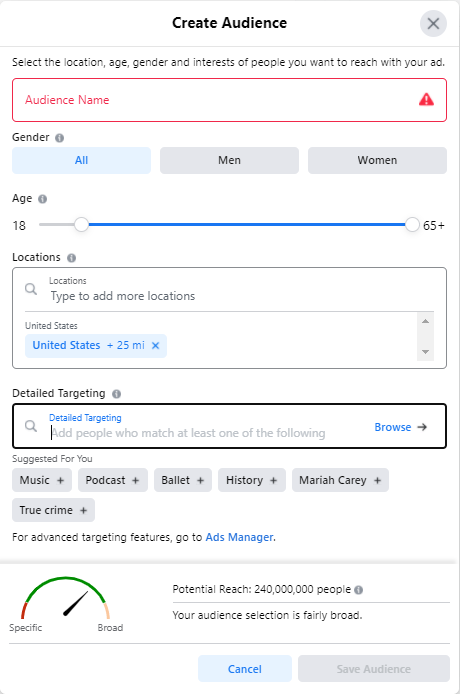
Finally, you'll be able to select the devices you want to target and where you want your ads to show up.
Facebook recommends using auto ad placement, but if you disagree, you can just as easily decide where you want your ads to go and what device you want them to target.
Many social media platforms make all these decisions for you. But Facebook puts you in the driver's seat because they know you'll likely do the best job of finding your ideal customers.
You, after all, know your target market best.
Want to make the most of Facebook's marketing features? Here's a quick rundown on how to dominate Facebook marketing.
Understanding Facebook's Lookalike Audiences
Facebook allows you to create lookalike audiences or smart audiences. They use the data from people who have previously engaged with your ads or page and create an audience they think is best.

That means that if you have an audience that is performing remarkably, you can create a similar audience that should also perform well.
Instagram Integration
Did you know that when you create an ad on Facebook, you can also run that ad on Instagram by clicking a single button?
That's right. It takes you no extra work.
You can click the Instagram ad placement button and select "Feed," "Stories," or both.
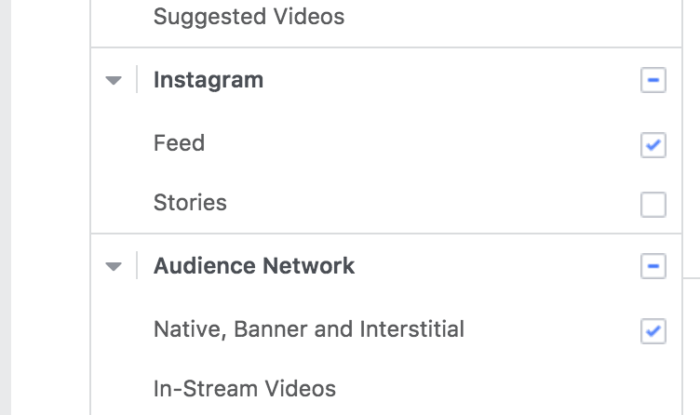
If your ad is highly visual, you might want to consider using this automatic integration. It will expand your reach with no extra work.
Facebook Live
People love Facebook live.
There's just something about live video that makes it more appealing.
Maybe it's the chance that people will mess up. Maybe it's the transparency. Maybe it makes us feel more connected.
Whatever the reasons, the fact is the same: People enjoy live video at least as much as they do traditional videos.
Users watch live videos for 27 percent longer than they do pre-recorded ones.
In other words, live video might be well worth your marketing time and money on Facebook. Here are Facebook's instructions on how to go live.
Facebook Marketing Resources
- Facebook for Media
- Facebook Marketing: A Complete Video Guide
- The Facebook Marketing Ninja Podcast
2. Instagram
Instagram is and was always about pictures, and its video function is pretty popular too. Out of all of the big networks, Instagram has the highest engagement rate.
You can also release short or long-form videos and share Instagram stories. Both formats do well for brands.
Tools like InVideo can help you create and edit professional videos that increase engagement and reach more people.
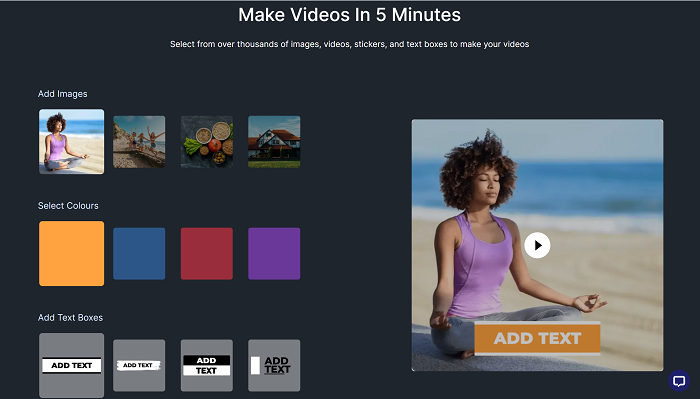
But, if I were to start a new Instagram account from scratch, I'd focus mostly on pictures. Here are a few categories that work well:
- inspiring quotes
- questions in text form to they engage your followers
- well-done product photos
Of course, you must also make use of hashtags, give a call-to-action with each photo, and make sure that you're using your bio is properly optimized.
You can also focus on Instagram influencer marketing.
Influencer Marketing on Instagram
If there is one social media platform that represents the pinnacle of influencer marketing, it's Instagram.
The reason for that is difficult to understand.
Perhaps it's because the platform is so visual. Or perhaps it's because advertisement overloads haven't yet annoyed the userbase.
Or perhaps the influencers enjoy sporting their content more on Instagram than on Facebook, Twitter, or the like.
Whatever the case, Instagram is winning big.
It's no surprise, then, that 65 percent of brands participate in influencer marketing.
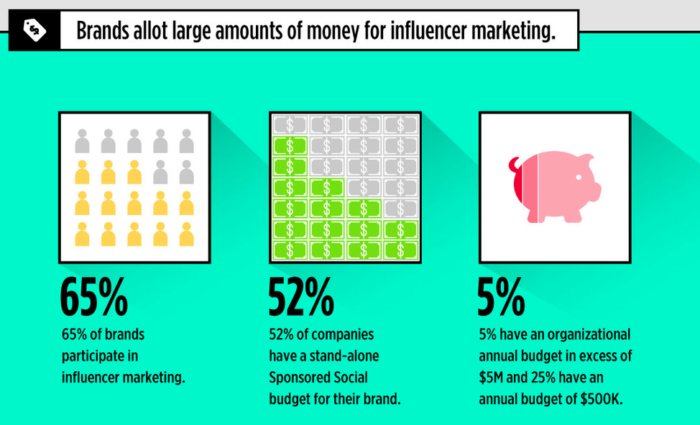
You might want to consider joining them.
Instagram Stories are Stealing Users From Snapchat
Instagram Stories is a feature that lets users create a coherent series of pictures, videos, or gifs.
The feature exploded the moment that Instagram created it.
In fact, in 2017, the number of people using Instagram Stories passed the number of users on Snapchat, which is a similar platform.
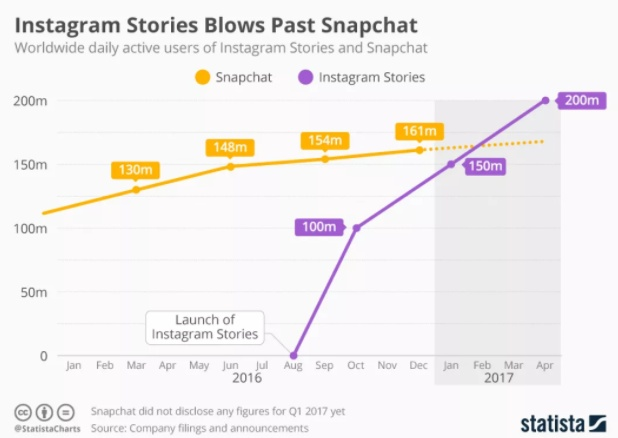
In other words, if you're going to use Instagram, then you should probably create a Story of your own.
Perhaps you should create a Story that shows users behind the scenes of your business or offers special deals.
How Brands Are Using Instagram Today
Instagram is one of the top best social media platforms for user engagement.
Of course, that doesn't mean that you can't sell on the platform and market your products as well, especially now that there are features like product tags and links in Stories.
Pushing for audience engagement first, before you try to sell, is your best bet. Then, once people learn to love your brand, they'll buy from you.
Additional Instagram Marketing Resources
- Instagram Marketing Cheat Sheet
- Best Instagram Marketing Tips
- Instagram Advertising Guide
3. YouTube
This social network has changed the way we consume video since it has made it easy (streaming is super fast) and free, and it gives us a way to express our opinions instantly (thanks to comments).
Almost 5 billion videos are watched on YouTube every single day.
YouTube has spawned entire industries and kickstarted thousands of careers.
For marketers, it's a great way to share long-form content with your audience, especially if they're not avid readers. For example, you could turn your blog posts into video tutorials.
Pro tip: Use other social media channels to drive your followers to YouTube by giving excerpts, snippets, and previews of your videos. The little, bite-sized teasers will spark curiosity and make people want to see the whole thing.
There is no limit to how long your videos can be, and people have published entire courses in the form of a single, three-hour video.
If you're trying to be funny, you should be funny on all channels. It doesn't make sense for your brand with a blog about PPC advertising to suddenly make animal jokes on YouTube. You'd be better off teaching some of your strategies on video.
Don't overcomplicate this. You don't need high-quality recording equipment or fancy editing. The chances are good that you are a few steps ahead of most people in your niche, so just get in front of your webcam and start teaching.
As Nathan Barry says:
Teach everything you know.
The Rise of DIY Video Filming
With social media, anyone can become a star, and YouTube is no different.
Sure, since YouTube is video-based, it requires a bit of videography knowledge and a bit of the right equipment. With decent light, a microphone, and a camera, your business can start using YouTube to drive traffic and generate leads.
Even your iPhone will do.
Post-Production and Editing
It's not just video filming that the DIYers are taking over. It's also post-production and editing.
In fact, every year it seems, new tools come out that allow people like you to edit your video content with ease.
For editing your own video content for YouTube, consider wevideo. It is free and easy to use.
You can use it to layer content, cut content, and even add new graphics.
What's not to like? Plus, it's free.
YouTube Video Ads
Finally, you might want to consider using video ads on YouTube.
Currently, there are several types of YouTube ads.
Depending on the type of ad you choose to use, viewers will either be able to skip your ad after a few seconds or YouTube will make them watch the entire thing.
Naturally, different strategies will work for different businesses.
Don't be afraid to try different things. A/B test to see what works best and what doesn't work at all.
In the end, your advertisement on YouTube will only be as good as your determination to find out what works.
Spend the extra time and money to do so.
You won't regret it.
4. LinkedIn
LinkedIn's growth never exploded as much as Facebook's, but they've been around for 18 years and have grown to over 774+ million members.
On LinkedIn, it's all about being professional. The casual writing style that's used on some blogs doesn't work as well on LinkedIn. People are there for one thing only: business.
They want to learn about what's new in their industries, who's hiring, who's firing, and how to optimize their performance at work.
A SlideShare about baking muffins won't do nearly as well as an in-depth company presentation from a tech conference.
If your content helps people expand their networks or conduct business in a better way, it has a place on LinkedIn. If not, you might want to focus on other channels first.
LinkedIn Groups
If you're familiar with Facebook Groups, then LinkedIn Groups shouldn't be difficult to understand and navigate.
Just think of Facebook Groups but for business people.
Basically, LinkedIn Groups are a place for like-minded professionals to gather and discuss topics of interest or establish their expertise.
You might want to consider joining one to establish your business as an expert on certain topics.
After all, the more people that believe your business knows what it's talking about, the more people who will work with you in the future.
It's an easy strategy for making connections and growing your content marketing audience.
LinkedIn Advertising
As with all social media platforms, you can also use LinkedIn to run your advertisements.
And if your business falls into the B2B category, LinkedIn might just be the best place for your advertisements.
In fact, LinkedIn is one of the most effective social media platforms for B2B companies. LinkedIn is also one of the top platforms for lead generation.
Evidently, since people on LinkedIn are there to talk business, they also don't mind interacting with businesses.
That means that your business can get some serious attention on the platform if you play your cards right.
Advertisements might just be the way you choose to do that.
Additional LinkedIn Resources
- How to Advertise on LinkedIn
- LinkedIn Marketing Guide
- Social Media Marketing Podcast – LinkedIn Marketing
5. Reddit
Reddit's slogan claims that they are the "front page of the Internet," and they aren't very far off. With 1.5 billion visits from May 2019 to May 2020, Reddit might just live up to its description.
Reddit is another college-originated social media site, and it's a very special one at that. It focuses entirely on community benefit. In fact, Reddit's users will ferociously attack you for spamming link bait or dumping promotional links on their boards (or subreddits).
If Redditors like what they see, they can easily drive enough traffic to your site to crash it. You shouldn't take a Reddit traffic storm lightly.
Two key factors that helped Reddit grow to such a massive platform are AMAs (Ask Me Anything) and their voting feature.
Users can upvote and downvote entries, links, and comments. The most popular and helpful submissions always show up on top.
Reddit rewards (or punishes) accounts with karma, which they display separately for links and text posts.
This way, users don't have to dig through tons of content before finding what's good. They can see what's popular right at their first glimpse.
The platform took off when celebrities started doing AMAs. During AMAs, Celebrities hang around on the platform for a while and answer user questions live.
People who have done AMA's include Barack Obama, Arnold Schwarzenegger, Tim Ferriss, David Copperfield, and even Bill Gates.
Reddit requires people to post proof that they're doing an AMA.
Reddit is tough to crack. You can't use it as another distribution channel and just submit a link every time you publish something on your blog.
You have to be present, communicate, and provide value to fellow Redditors without asking for anything first.
Submit funny and helpful links for a while just to build up your karma, and then refer back to your content. But only do so where it's appropriate. And be sure to make the links a side note rather than the entire content of the post.
Reddit Marketing Fails to Avoid
Reddit mostly hates marketers. It's not necessarily the fault of marketers, though. Reddit is just a unique community.
They don't like people who are too blatant in their marketing, and they don't like businesses trying to be pushy.
For that reason, even some of the top businesses have made massive mistakes on Reddit.
The CEO of a large outdoor gear retail chain started an AMA on Reddit, hoping to generate brand awareness.
Here's what he got instead.

That's a bit of a Reddit disaster, huh?
Take some time to understand the audience before you start using the platform to advertise and market. Once you do understand Redditors, though, the platform represents a well of marketing potential you won't be able to pass up.
Reddit Ads
If you don't want to try and grow an organic following on Reddit, then you can consider simply posting ads on the platform.
First, though, you'll need to determine if Reddit is the right place for your advertisements.
As we already discussed, advertising gone wrong can hurt instead of help your business on Reddit, so make sure that you know what you're getting yourself into first.
The platform consists primarily of males under the age of thirty (though other demographics are growing on the site), so if that isn't your target audience, you might want to advertise elsewhere.
If you're going to run ads on the platform, then be ready to respond to some serious heat. But if you live through the heat, you could harness some serious potential.
Additional Reddit Marketing Resources
- Marketers Guide to Reddit Advertising
- Using Reddit Ads to Generate Sales
- The Marketer's Guide to Reddit
6. Snapchat
Snapchat has 293 million daily active users. While the majority of those are women (about 61 percent), men on the platform have one thing in common: they're young. In fact, 69 percent of teens use Snapchat.
Since all images and videos disappear after 10 seconds max, content on the platform is fleeting and short-lived.
Naturally, it makes sense to provide content around that same theme.
For example, you could give your audience access to a live event. If you're giving a talk at a conference, take a few snaps when you're on stage and share them with your followers.
Let your audience behind the scenes. Show them the happy hour on Friday at the office, the IPO party, and even how you act when you're alone at home.
You could show them your practice run of the speech, how you screwed up your makeup, or what a cool car picked you up from the airport.
Snapchat marketing is all about sharing those precious moments that we all have so few of in life, so make sure that you use it for just that.
B2B Marketing on Snapchat
Can you market your B2B company on Snapchat?
Some people think you can't.
After all, a large portion of the current Snapchat user base consists of those who are teenagers or younger.
Don't let that young audience deceive you. As the platform finds its footing in the digital world, older populations are flocking to the platform as well.
In fact, one entrepreneur uses the platform to offer regular advice to other entrepreneurs.
HubSpot uses it to increase and establish its brand's personality.
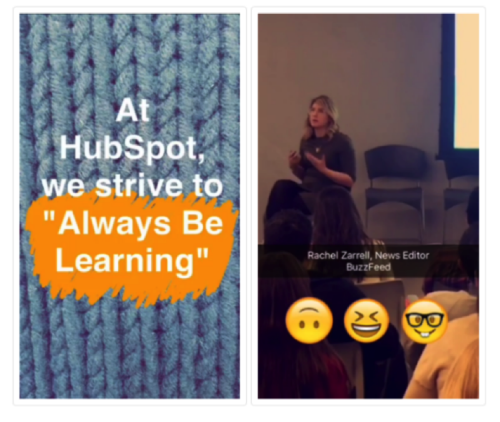
DocuSign used it to interact with people during a conference.
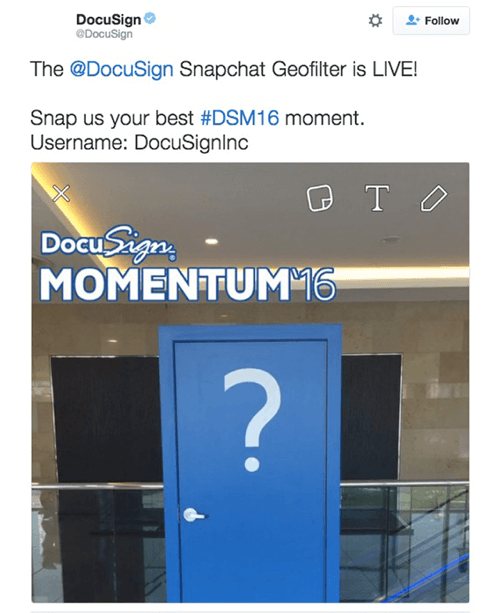
So yes. You definitely can use Snapchat to market your B2B company.
Plenty of other businesses are doing it, and you can do it too.
Of course, Snapchat requires a bit more creativity on your part than other platforms. Keep in mind that users can only view your images and videos once.
That should at least partly define the type of content you put out.
Plus, that restriction can also work in your favor. Since all your content is temporary, people might be more inclined to view your snaps while they can and fully take in the content. Once they do, it goes away.
Snapchat Marketing Resources
- Snapchat Guide
- 4 Principles of Successful Snapchat Marketing
- Snapchat for Business: The Ultimate Guide
7. Pinterest
Pinterest is the number one social media platform for marketers who want to target women. 60 percent of their monthly active users are female.
You can think of Pinterest as a giant digital scrapbook. Due to the nature of the pinboards, Pinterest is also one of the only platforms where images look best when you display them vertically. Keep in mind that your pics need special formatting to look good on Pinterest.
Between their closed launch in 2010 and 2012, you needed an invitation to get on the platform, so it's only been open to the public for five years. Nevertheless, the leads you acquire from Pinterest are high-quality.
Influencer Marketing on Pinterest
Since Pinterest allows users to market within whatever niché they like, influencers flock to the platform like hotcakes at IHOP.
Since you're a marketer within a specific niché, you can use those influencers to advertise your product to their existing audiences.
Growing your own audience takes a ton of time. And maybe, just maybe, you don't have a ton of time.
In that case, influencer marketing may be your answer.
There's a niché for everything on Pinterest. That further means that there's an influencer for everything.
Do you want to market clothing or tiny toy dogs or Harry Potter attire?
Believe it or not, there's a board for that.
Pinterest Ads and Buyable Pins
Of course, not everyone will want to go through the hassle of finding, talking with, and hiring influencers.
Some of you will simply want to run advertisements on the platform and get on with your lives.
In that case, remember that the majority of people on Pinterest are women.
For some of you, that's a good thing. For others of you, that's not such a good thing.
However, despite that gender-leaning, Pinterest is a remarkable platform for getting people to buy your products.
The best part is that the ads fit into the boards seamlessly.
If you have a product for women that's highly visual and you don't want to deal with influencers, then Pinterest ads are your solution.
Run them and see how it goes.
Pinterest Marketing Resources
- How to Use a Business Pinterest Account for Marketing
- Pinterest Ads: A Simple Guide
- Advertise on Pinterest: How to Get Started
8. TikTok
TikTok, a Chinese video-sharing app, first launched in 2016. Unlike other social media apps with humble roots in basements or dorm rooms, the company is the result of two different apps merging. Today, the app has more than 800 million active users around the globe.
TikTok users share short video clips of themselves dancing, lip-syncing, or sharing thoughts about politics and social justice matters. The app stands out due to the number of interactive features, such as filters, music, and editing capabilities that allow users to be incredibly creative.
TikTok Marketing
Why consider marketing on this highly popular video app? For starters, competition is low. Most businesses aren't bothering with it yet — and ads are still quite affordable.
The new-ish platform is also a great place to get creative and try out fun strategies that might not work on more formal platforms, like LinkedIn.
Are you considering diving into the world of marketing on TikTok? Here are a few ways to leverage the platform.
TikTok Marketing Videos
The most straightforward way to market on TikTok is by creating exciting content related to your brand.
For example, you could create short how-to videos about topics related to your brand. Use a keyword research tool like Ubersuggest to find topics your audience cares about, and then create short, snappy videos for TikTok.
You could also use the fun style of TikTok to introduce your team members, show off your headquarters, or highlight the features of a new product. Consider using the platform's interactive elements, such as polls.
Influencer Marketing on TikTok
If you want to improve your engagement rates, consider working with established TikTok influencers in your market. The average US influencers on TikTok have a 17.99 percent engagement rate, making influencers a powerful tool for brands.
To find influencers, use the search feature to look for hashtags related to your industry and look for users posting high-engagement content.
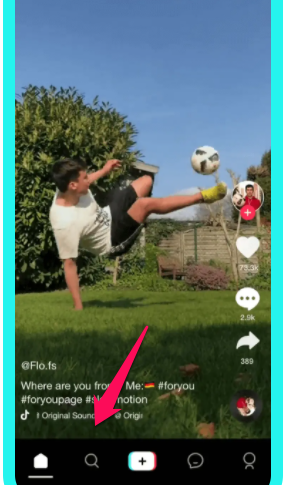
You can also use the Influencer Marketing Hub's free influencer search tool. Just type in a topic of interest, and the tool will provide a list of up to 10 relevant influencers.
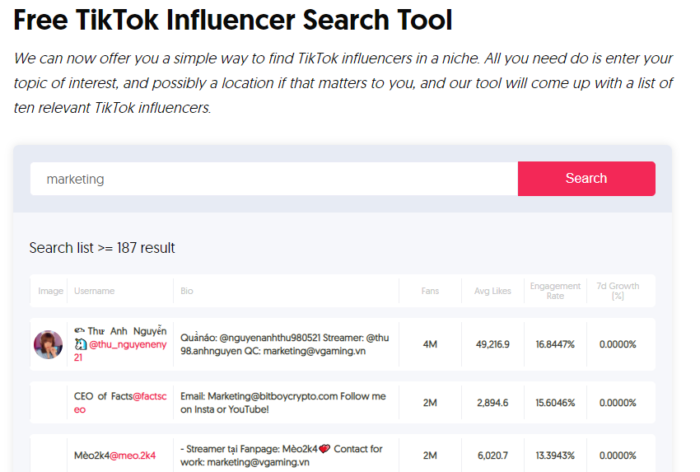
TikTok Ads
TikTok gives brands four different options for paid ads: brand takeovers, native ads, branded lenses, and hashtag challenges. Before diving into these, you'll want to understand the differences:
- Brand takeovers: Exclusive category takeovers that show up in users feed, before any of the accounts they follow.
- Native ads: Similar to boosted posts on Instagram, these ads give your posts a wider reach.
- Branded lenses: Design and promote a filter related to your brand, similar to Snapchat's sponsored lenses.
- Hashtag challenges: TikTok is known for sending challenges viral. Hashtag challenges allow the brand to use banner ads to improve challenge visibility.
TikTok Marketing Resources
- How to Advertise on TikTok
- TikTok Marketing Tips from the Pros
- How to Get on TikTok's For You Page (FYP)
9. Tumblr
Tumblr is sort of a mix of a blog, Instagram, and Twitter. The owners call it a microblogging platform.
As Tumblr itself puts it, the platform is "so easy to use that it's hard to explain."
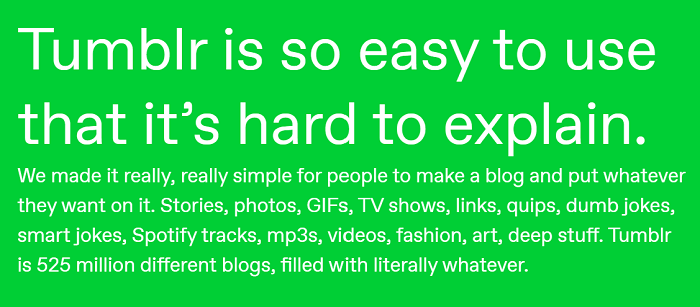
This platform is primarily useful for curating images. Users can easily reblog and like these images sort of like retweets and favorites.
Now, users create over 15 million posts each day, and the site makes money with advertising.
There's one type of file, however, that Tumblr is clearly the number #1 platform for GIFs. The animated, moving images are right in between photographs and videos.
Funny memes, animated clips, and short video excerpts make users scroll endlessly and binge-consume the content.
If you're in fashion, design, photography, or another visual industry, be sure to take a very serious look at Tumblr.
Tumblr Audience Demographics
The audience on Tumblr is a bit different than any other social media platform.
Most of the people are on the platform to have fun. They are there to share funny comics, memes, and gifs.
They aren't particularly friendly toward marketers, however. But that doesn't mean that you can't market on the platform. It simply means you need to be more creative when you're doing so.
In fact, Tumblr is a great place for your marketing strategies to take form.
Additionally, the vast majority of Tumblr users are young. Most are millennials.
While you keep in mind that the users are young, also remember that they're on Tumblr for entertainment.
They aren't there to find products, and they definitely aren't there to hear about your brand message.
One company recognized this with their product, the Holy Meme Bible.
They realized that Tumblr loves memes and that the people there would likely respond well to their product.
So, for three weeks, they went full-board and marketed their Meme Bible on Tumblr.
As a result, they made over $200,000 in sales in three short weeks.
If you have a product that works for the Tumblr audience, then you're doing yourself a serious disservice by not using the platform to market your product.
Tumblr Marketing Resources
- How to Get Paid Ads on Tumblr
- The Marketer's Guide to Tumblr
- 3 Tips for Successful Content Marketing on Tumblr
10. Medium
Medium isn't social media in the traditional sense. It's closer to social journalism, as it's a place where big-timers and everyday people alike can share knowledge through long-form posts. The format allows for social connections without (usually) as much animosity as can appear on other platforms.
Since it's a blog platform, Medium naturally does well with long-form content. However, posts shouldn't be too long.
Medium shows the estimated reading time for each post right anywhere you see them, whether on the home page or at the top of the individual articles.
If people see that it'll take 20 minutes to read your post, you'll scare most of them away. Most users aren't willing to make such a big time commitment.
Seven-minute (approximately 1,600-word) posts do best, so it makes sense to break up longer articles into a series of posts.
If you have a big following already, you can use it to catapult your articles to the top since the posts that users recommend the most land in the featured stories where most users will see them.
As few as 50-100 recommendations within an hour or two can drive your article right to the front page.
Big outlets like Huffington Post, Business Insider, and Entrepreneur often pick up content that has done well on Medium. That gets it additional exposure.
Medium Audience Demographics
Medium receives 200 million visits per month, give or take a few thousand. The majority of the traffic comes from the United States.
This offers a lot of potential to get your business in front of new prospects. Also, keep in mind that the majority of visitors to the site are men with an above-average education.
Similar to LinkedIn, Medium is ideal for posting content that's more professional in nature.
You can publish content tagged for specific niche topics. Doing so may not get you the attention of as many people as you would on Facebook or larger social networking sites, but because the following is narrower, you'll likely get a higher percentage of the right people to interact with you and your brand.
So, what's the verdict: should you use Medium?
If the topics you blog about relate to more serious matters, then you have nothing to lose by posting them on Medium. In fact, there's much you could gain.
Marketing Content on Medium
If your content is relevant for Medium users, then using the platform for marketing is a no-brainer.
In fact, using the platform to benefit your business will require almost no additional effort.
All you have to do is take blog posts that you've already written and repost them on Medium. Since you still own the rights to the content on Medium, you can do with it as you like. It's an easy way to get additional eyes on all your hard work.
What do you have to lose?
You can use Medium to easily get your blog content in front of new eyes, and it won't take you any extra work to do so.
Just copy and paste content from your website, and voilâ! More people see it than before.
As an aside: Unlike other sites, Medium is really picky about what it allows in terms of advertising. You can link to your own stuff to a certain extent and use affiliate ads (with proper disclosure notices), but nothing remotely third party is allowed. Medium is not free for users as a result; after a couple of free articles, they need to pay $5 per month.
Medium Marketing Resources
- The Marketer's Guide to Medium
- How to Promote Your Medium Posts
- Going Viral on Medium
11. Quora
Quora is unique from other social media platforms as it's strictly based on the questions and answers.
Now, you might think "People ask questions and get answers on Facebook and Twitter all the time. Why use Quora?"
Two reasons:
- The answers on other sites are sometimes not answers at all, personal stories, and, far too often, just plain mean.
- People on Quora can establish authority without having to explain their qualifications over and over.
For instance, on Facebook, someone in a cat group may ask how to fix a mistake they made while cutting their own hair. While some folks may give kind, helpful responses, chances are they'll also get a lot of rude answers about their "poor decision-making skills."
While answers like that on Quora aren't unheard of, the questions are more likely to be taken seriously and, at times, answered by true experts whose credentials are shown next to their names rather than hidden in their comments.
People have built entire platforms from answering questions on Quora, and some answers boast more than 1 million views.
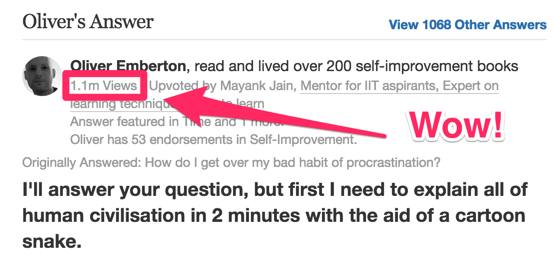
This platform centers around one thing: questions. You can get the most out of it by providing quality answers to popular questions that users have re-asked lots of times.
Thanks to the voting system, quality answers make it to the top. And, they usually stay there for a long time.
Try to give answers that will still be valid in a year or two or even five. Some of the most popular Quora answers came from years ago. Emberton's answer above was written in 2014 and the number of views continues to grow!
You can double your benefit from Quora if you use it to come up with content. For example, you could write a blog post that gives a very detailed answer to a popular question.
Again, going back to that Emberton screenshot from just a bit ago: He literally responded with a blog post, complete with graphics!
Not only will you have a great blog post then, but you'll also be able to republish it as the answer to that question.
This will also help you build a reputation as an expert on your topic. If someone likes an answer that they read from you, they'll often browse through the other answers that you've given.
Quora and Content Marketing
There are two ways to market yourself on Quora: Answering questions and creating ads.
Quora is a great place for establishing yourself as an expert on a certain topic, and you can do so by answering questions created by other users.
The first thing to do is fill out your profile. Once you sign up for an account, you can give some basics:
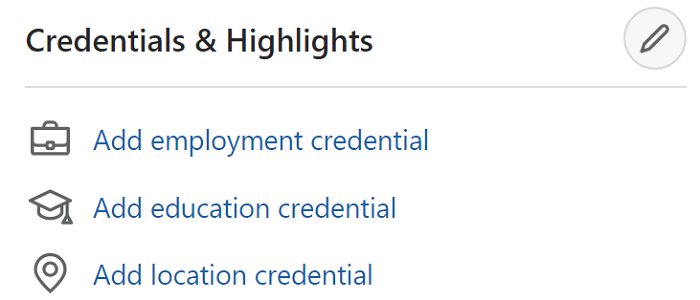
Some people have their credentials verified; others don't. Profiles are only verified if a high number of people recognize the person or brand behind the account.
This doesn't mean unverified profiles are lying, nor should being a smaller brand stop you from using Quora because you can't be verified.
Heck, it's not easy to become verified—the first-ever verified Quora profile was Barack Obama, and the rest on the first-round list to be verified were also household names.
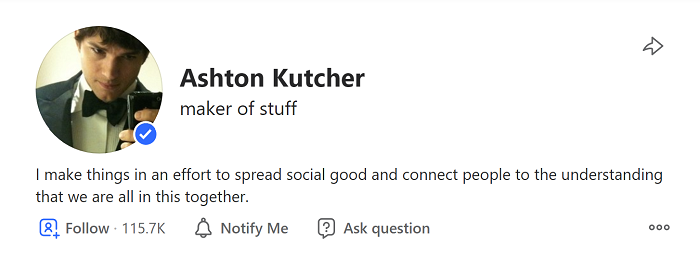
Regardless of if you're verified, once your profile is filled out, begin to answer your target market's questions. Imagine, for instance, that you're a digital marketer and you want to start establishing yourself as an expert in the digital world.
You can go to Quora and answer questions like these.
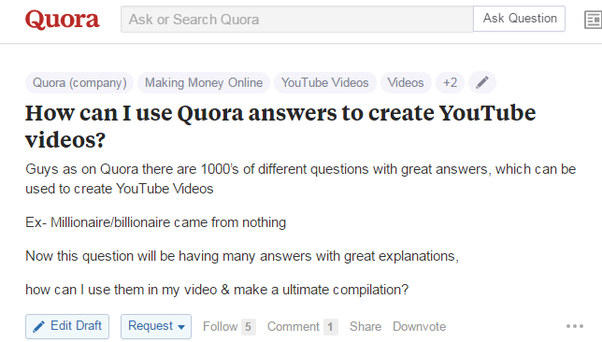
Then, if your answer is remarkable, people may upvote it, making it a winner in the Quora SEO system.
In case that's not good enough, you can also use Quora to find topics for your own blog.
Fortunately, Quora makes it easy.
Simply go to Quora and type in your niché. Browse through the questions people are asking.
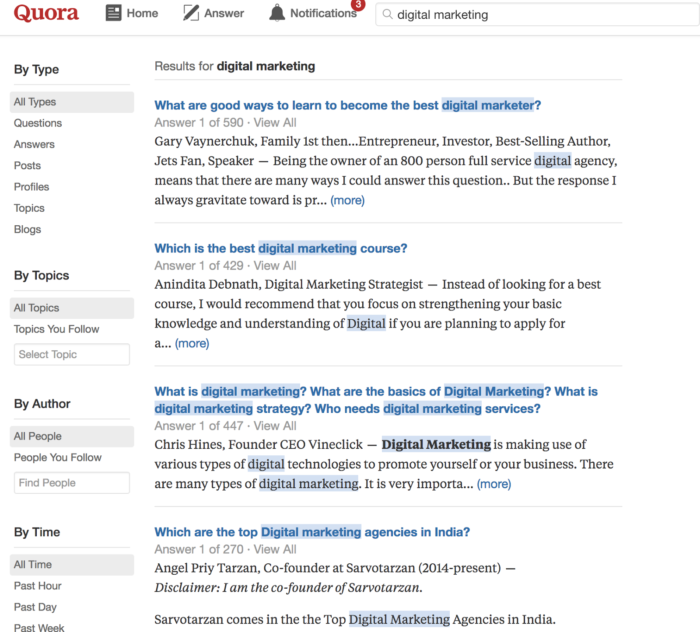
Then, all you have to do is take those same questions and create your own website content around them.
You can just make good old-fashioned ads on Quora.
You can structure them like other Quora posts, with questions and answers, like this ad for SiriusXM:
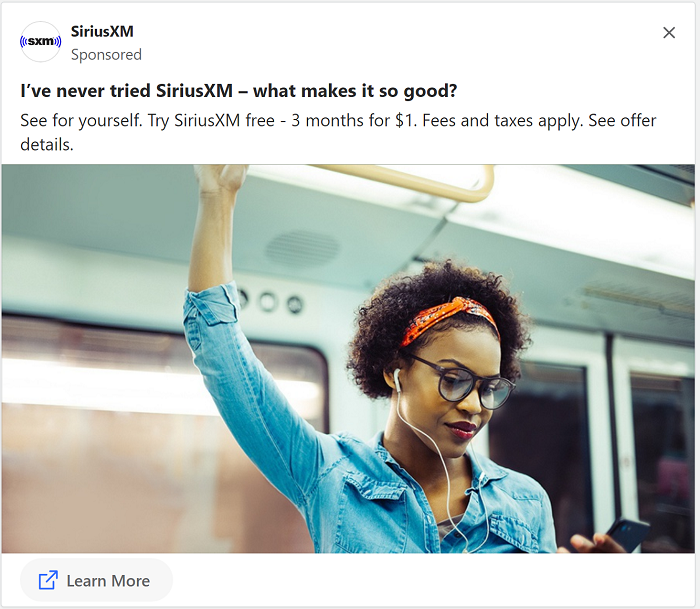
Or have them look more like traditional ads, like Spokeo did:
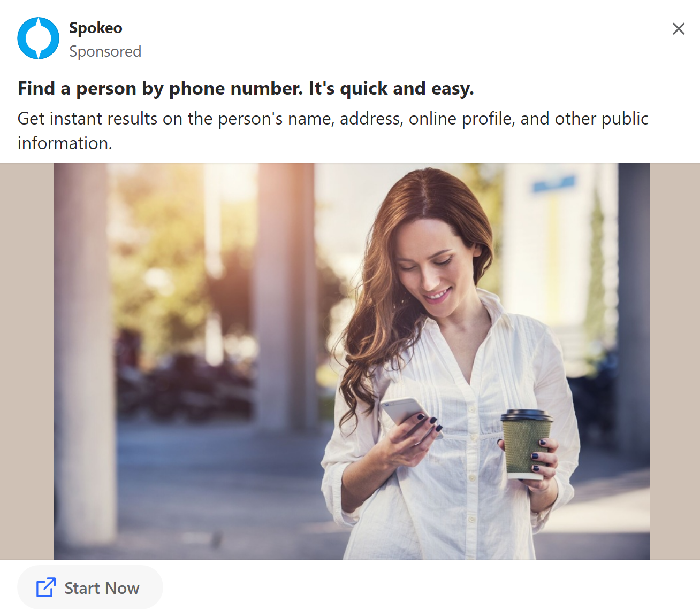
Users can't respond directly to your ads on the site—they can only follow whatever links you include.
Quora Marketing Resources
- How to Use Quora for Marketing
- How to Create a Quora Marketing Strategy
- How to Generate Long-Tail Keywords Using Quora
Tips to Grow and Engage your Audience on Social Media
Social media success begins with understanding your prospects and what they want from your brand.
From there, you can create content that resonates with them based on their shared interests.
With such an approach, you can build a loyal fan base that spreads the word about your brand organically.
You can achieve this by:
- creating a social media strategy with a concrete goal in mind know why you are posting on social media and what you want to achieve by doing so
- choosing the right social media channels for your company or industry
- experimenting with different content types such as live video or GIFs
- keeping track of current trends in your industry and adapting your marketing strategy accordingly, but don't copy what other companies are doing; great advertising campaigns integrate something new!
- holding contests and inviting user-generated content
- sharing useful content
- starting conversations and writing actionable content to inspire people to click through, read more, or even download your free brochure or mobile app
- connecting with influencers
- following your competitors and learning from them
- using hashtags
Remember not to ignore the basics.
Above all: share great, original content, and get to know your followers' wants and needs.
Provide them with the products/services that address their everyday problems, and you'll soon see your social media marketing efforts take off.
How to Build a Social Media Marketing Strategy
A social media marketing strategy is critical for any business looking to get the most out of its online presence.
The best way to create a successful social media strategy is to focus on the following factors:
- target audience
- content
- engagement
- social channels
Many companies are trying to reach their target demographic through social media. This is a way to build a brand, increase customer loyalty and generate word-of-mouth marketing.
There is no one right strategy for everyone. The first step is to find out where your target audience is hanging out on social media and what they are interested in. The next step is to figure out the best times of day or week for you to post on these platforms if you want maximum visibility and engagement with your content.
Finally, make sure you are consistent with your posts and don't stop posting just because it feels like you aren't getting any likes or comments, it will come!
Additionally, you should:
- Set goals and work toward them.
- Understand your audience and their individual wants and needs.
- Decide reach metrics to track. These will depend on your aims. For example, if you're looking for engagement, track impressions.
- Create content that gets clicks. That means sharing inspiring content, news stories, answering questions, and posting at the optimum times.
- Assess and update your strategy as needed.
Social Media Marketing Tools
Most businesses could benefit from a social media presence, but many business owners lack the time. The solution?
Social media tools.
These tools are an essential part of digital marketing, allowing users to measure the performance of their posts, create and publish content, engage with customers on social media, and much more.
They come in three main categories: social media management, social advertising, and content creation.
- Posting platforms: These tools help you automate publishing on various platforms like Facebook, Instagram, and LinkedIn. Some of them also provide scheduling features. Popular tools include Agorapulse, Buffer, and SproutSocial.
- Content creation and curation: These tools help you create content like videos, slideshows, or GIFs for Facebook or Twitter posts in minutes. ContentStudio, Drum Up, and Content Gems are just some of the sites out there.
- Social advertising: This includes Facebook and Twitter Ads that allow you to promote your content to specific audiences.
There's also a host of social media management tools to help with publishing, scheduling posts, monitoring, and competitive analysis to simplify things further. Think about the aforementioned Hootsuite or SocialPilot.
Additionally, there's one extra player when it comes to social media marketing tools: people. If you're doing research because you don't have an in-house marketer (or you are one and you're struggling), there's no shame in getting help. Marketing agencies around the world are great tools for content creation, scheduling, strategizing, and consulting services.
Social Media Marketing FAQs
What is meant by "social media marketing?"
Social media marketing means marketing your brand on social media channels through organic, paid, and networking strategies
How do I know which social media channel to market on?
Determine your target audience, then find out which platforms that demographic spends the most time on.
Which social media channel has the most users?
Facebook has the most users of any social media platform.
What are some social media marketing blogs I can read to learn more?
Social Media Marketing Conclusion
You now have an overview of the 11 most important social media platforms. But that's just the tip of the iceberg.
Figure out where your target audience is and get active on that platform with your best advertising and content marketing strategies.
You now know how each platform got to where it's at, what the context of each channel suggests that you do, and you know how to come up with good content for each of them.
Will you change your social media branding strategy ?
Source: https://neilpatel.com/what-is-social-media-marketing/
0 Response to "Tumblr Funny Snapchat Tumblr Funny Snapchat Drawings"
Postar um comentário